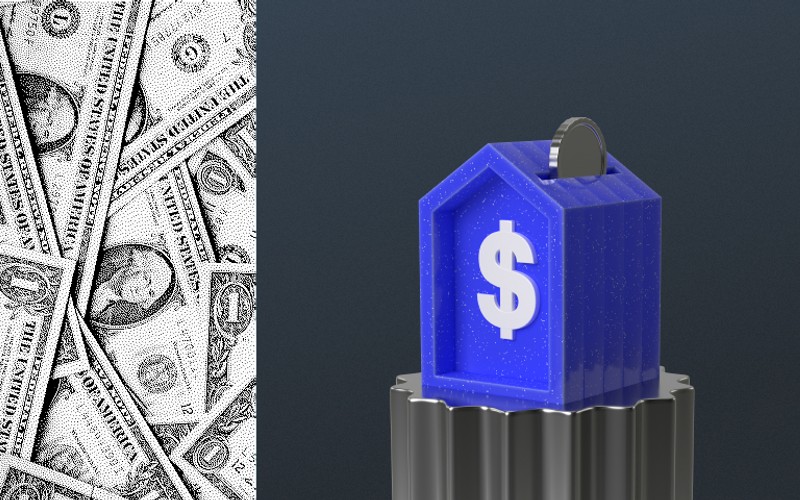As a homeowner, you may have more borrowing options available. One of these is a home equity loan, where you can borrow against the equity you’ve built in your current home.
Unlike credit cards and other revolving forms of credit, a home equity loan gives you access to a lump sum of cash that can be used to finance a large expense. Here’s what you need to know — and the risks.
What is a home equity loan?
A home equity loan is a type of loan where you use the equity you’ve built in your home as collateral to borrow money. With a home equity loan, you receive a lump sum payment that you repay over a fixed period, usually between five and 20 years, at a fixed APR (annual percentage rate). Mortgage lenders typically require at least 20% equity in your home, but some may allow borrowing up to 90% of the value of your home.
As you steadily pay down your existing mortgage, or if property values appreciate, your equity grows, making you eligible for a home equity loan. However, it is essential to consider the potential risks, such as the possibility of losing your home if you default on the loan payments.
How does a home equity loan work?
It’s important to consider the terms, interest rates, fees, and repayment options before taking out one of these loans.
Here’s the key factors to consider:
- Equity calculation: Equity refers to the portion of your home’s value that you own outright. The lender determines the equity you have in your home by subtracting the remaining mortgage balance from the home’s current market value. The amount that a homeowner can borrow will be based on a combined loan-to-value (CLTV) ratio of 90% or less. This means that the total of the balances on the mortgage, any existing HELOCs, pre-existing home equity loans, and the new home equity loan cannot be more than 90% of the home’s appraised value.
- Loan approval: Lenders will review your creditworthiness and income before approving the loan. Your loan terms, including home equity loan rates, depend on your credit score and repayment history.
- Lump sum disbursement: Once approved, you’ll receive a lump sum amount, which you can use for home improvements, debt consolidation, education, health bills, or refinancing high-interest debt, such as credit card debt.
- Fixed interest rate: Home equity loans often have a fixed interest rate, meaning the interest rate remains the same throughout the loan term, providing predictability in monthly payments.
- Repayment period: You’ll repay the loan over a predetermined period through regular fixed monthly payments. These payments usually include both principal and interest.
- Collateral: Your home serves as collateral for the loan, which means that if you default on your payments, the lender has the right to seize your property through foreclosure to recover their money.
- Tax deduction: Sometimes, the interest paid on a home equity loan may be tax deductible. However, it’s advisable to consult with a tax advisor to understand the specific tax implications.
Pros and cons of home equity loans
Before applying for a home equity loan, it’s essential to consider the pros and cons based on your money needs and financial situation. While home equity loans offer advantages, they also have drawbacks. Here’s what to keep in mind when considering a home equity loan.
Pros of home equity loans:
- Often lower interest rates compared to personal loans or credit cards.
- Fixed interest rates provide stability and predictable monthly payments.
- Potentially longer repayment terms compared to other consumer loans.
- More straightforward qualification process compared to some other loan types.
- Immediate access to a lump sum of cash.
- Possible tax deductions on the interest paid if used for home improvements or home renovations.
- Allows you to keep your existing low mortgage rate if it’s favorable.
- Provides an easy source of cash for various purposes, such as debt consolidation, home improvements, or medical expenses.
Cons of home equity loans:
- Having a second monthly payment in addition to your primary mortgage.
- Risk of foreclosure if you default on the loan.
- The remaining balance of the home equity loan becomes due if you sell your home before fully repaying the loan.
- Closing costs or origination fees involved in obtaining the home equity loan.
- Less flexibility compared to a Home equity line of credit (HELOC).
- You’ll pay interest on the loan balance, even if used incrementally.
- Missed or late payments can put your home at risk.
What is needed to apply for a home equity loan?
To secure a home equity loan, you’ll need to meet certain requirements the lender sets. Here’s a breakdown of the general criteria:
Home equity
You’ll need significant equity in your home to qualify for this type of loan. Lenders will look at the loan-to-value ratio or LTV ratio on a property, a financial metric used to assess the risk of a loan.
The LTV ratio measures the relationship between the loan amount and the appraised value of the property. It is calculated by dividing the loan amount by the appraised value and multiplying the result by 100 to express it as a percentage.
The LTV ratio helps lenders determine the level of collateral protection they have in case the borrower defaults on the loan. Lenders prefer a loan-to-value ratio of 80% or lower for a home equity loan. This means they want borrowers to have at least 20% equity remaining in their home after taking out the loan.
Debt-to-income ratio
The debt-to-income ratio, or DTI, is a financial measure lenders use to assess a borrower’s ability to manage additional debt. It compares the borrower’s total monthly debt payments to their gross monthly income and is expressed as a percentage. Lenders prefer a debt-to-income ratio of 45% or lower to ensure you can handle additional monthly payments.
Some lenders may also consider the debt-to-equity ratio, which assesses a property’s long-term debt compared to its equity. A favorable debt-to-equity ratio typically falls within the range of at least 70% debt and 30% equity, equivalent to a ratio of 2.33.
Credit score
A higher credit score improves your chances of getting a higher loan amount and a lower interest rate. While each lender sets their credit score requirements, generally, higher credit scores are ideal for home equity loans.
How long does it take to get a home equity loan?
The timeline for getting a home equity loan can vary from a few weeks to a few months, but here is a general list of factors that can influence the speed of approval:
- Documentation gathering: Collecting the necessary documents for application, such as mortgage statements, property tax bills, and proof of income, can take time.
- Lender review: The lender will evaluate your application, credit history, income, and other financial information.
- Appraisal: An independent appraiser will assess the value of your property to determine the loan amount.
- Underwriting process: The lender will review all the information provided and decide on your loan.
- Closing preparations: If approved, the lender will prepare the closing documents and coordinate with other parties.
- Closing appointment: You will sign the loan documents and complete the closing process.
- Funding: After the loan documents are signed, the lender will release the funds to you.
The entire process can vary in timing depending on document availability, appraisal scheduling, and the efficiency of the lender’s underwriting and closing processes.
The difference between home equity loans and HELOCs
A home equity loan and a HELOC are both types of loans that allow homeowners to access the equity in their homes. However, there are a few key differences between the two.
A home equity loan provides a lump sum of money upfront, which borrowers receive in full at the beginning of the loan term. Repayment is made through fixed monthly payments over a set period, typically at a fixed interest rate. This type of loan is ideal for one-time expenses or projects with a fixed cost, as borrowers cannot access additional funds once the loan is fully disbursed.
On the other hand, a HELOC offers a revolving credit line. Borrowers are approved for a maximum credit limit, and they can access funds as needed during the draw period. During this period, borrowers make interest-only payments. The rates are often variable interest rates and tied to a benchmark rate. This flexibility allows borrowers to use the funds for ongoing expenses or projects with varying costs. Additionally, once a portion of the borrowed amount is repaid, borrowers can reaccess the funds.
Build your investments through Arrived
Arrived provides a platform for individuals to explore property investment with the potential to diversify their portfolio across multiple homes without the requirement of saving for an upfront down payment or the responsibilities of property management.
The opinions expressed in this article are for general informational purposes only and are not intended to provide specific advice or recommendations for any individual or on any specific security or investment product. The views reflected in the commentary are subject to change at any time without notice. View Arrived’s disclaimers.







